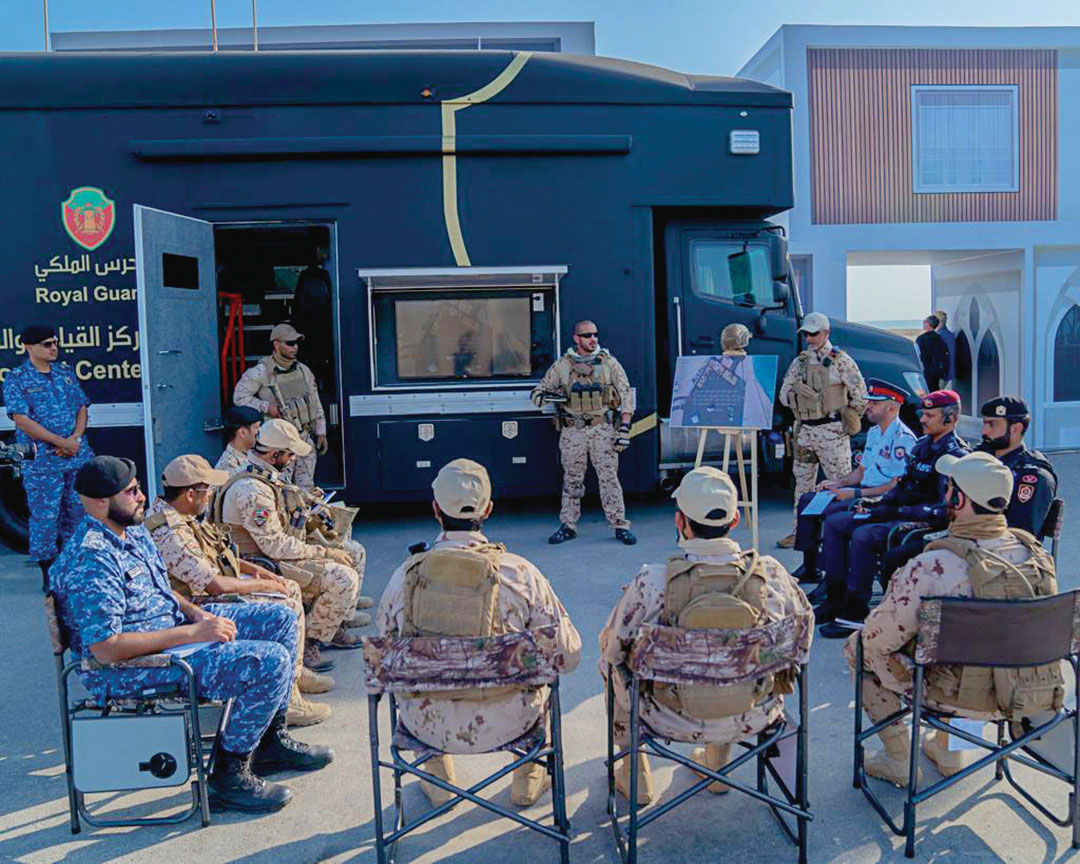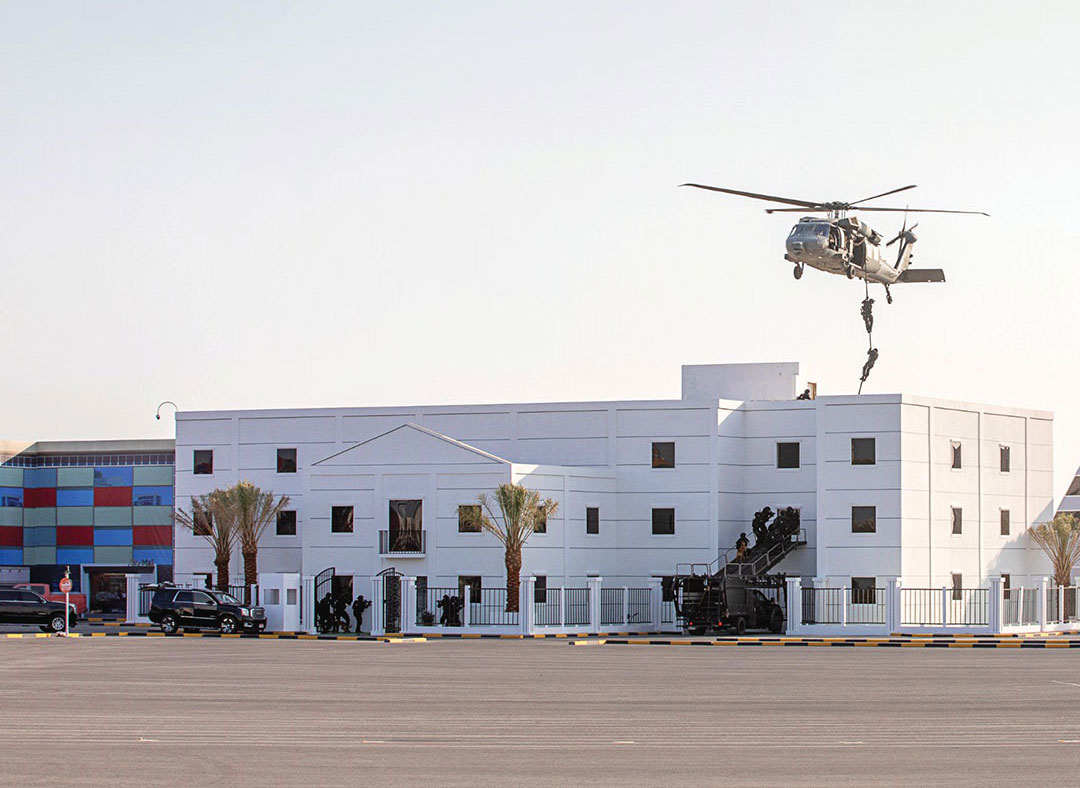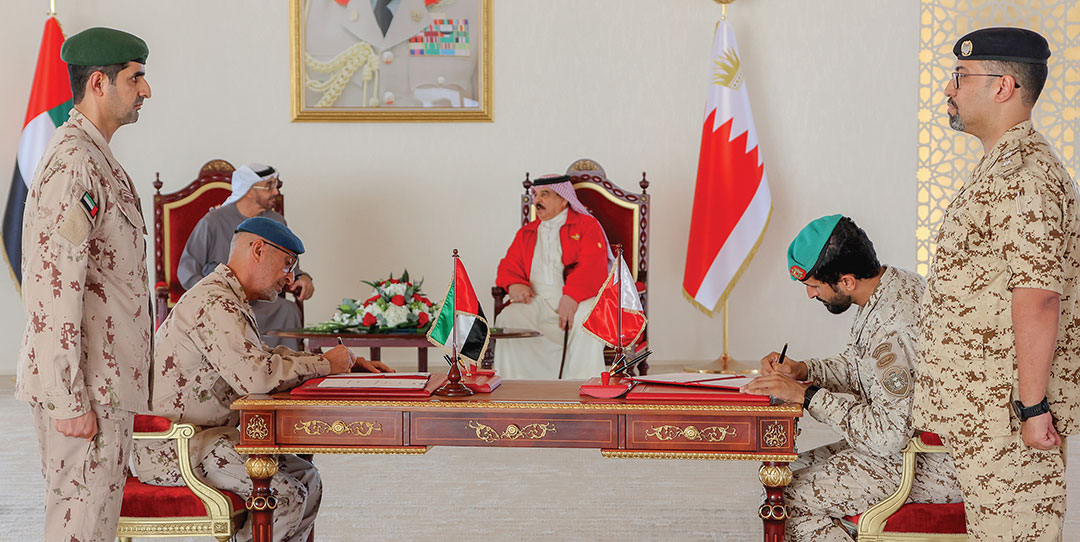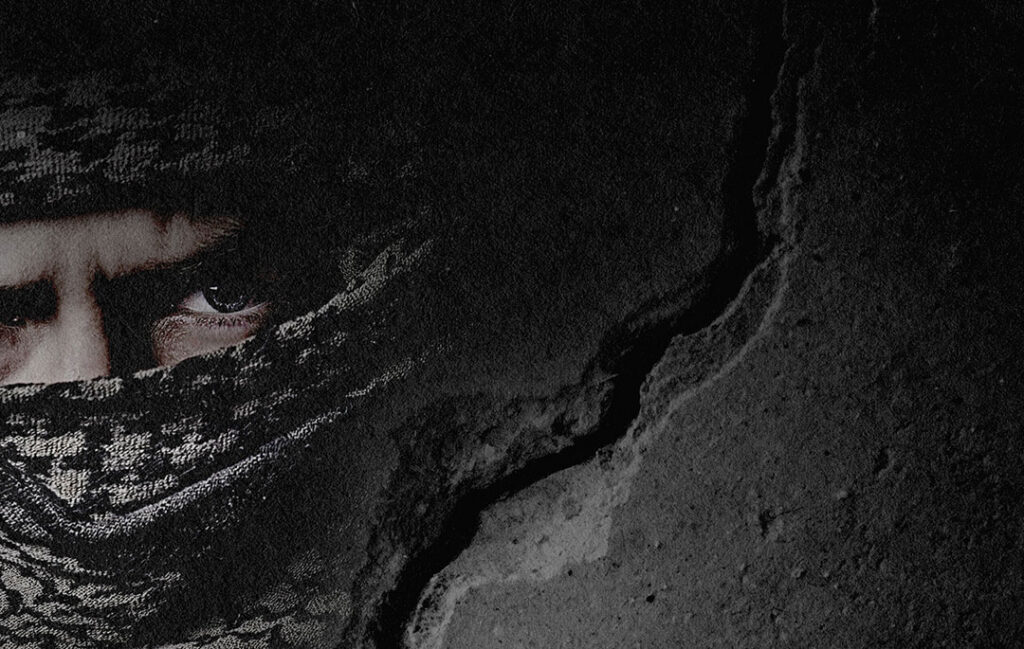Counterterrorism relies on accurate intelligence work and the timely exchange of information between security services and friendly nations. Because terrorist groups hide among the local populace and use civilians as human shields, countries must emphasize rapid response efforts and high-level coordination between security services to protect the lives of citizens, preserve public property and prevent terrorist groups from implementing their plans. It was for these reasons that Jalmood 3 — the joint Bahraini-Emirati counterterrorism exercise — took place in November 2022.
The final stage of the exercise was completed in the presence of Commander-in-Chief of the Armed Forces His Majesty King Hamad bin Isa Al Khalifa and United Arab Emirates President and Commander-in-Chief His Highness Sheikh Mohamed bin Zayed Al Nahyan. In a spirt of close cooperation forged over decades, the Royal Guard of Bahrain and several other units from the Bahrain Defence Force (BDF), Ministry of Interior and National Intelligence Agency units participated in the exercise alongside their brothers of the United Arab Emirates Armed Forces.
The Kingdom of Bahrain and the UAE objectives included timely communication at the strategic level, prompt exchange of intelligence reports related to terrorist activities that threaten the security of regional states, a rapid response to terrorist threats and coordination in an operations environment.
The Kingdom of Bahrain also focused on quick response times and building operational cohesion among the Ministry of Interior, the BDF and other state institutions, and placing all participating security services and emergency teams under a unified field command with a single commander.
The UAE emphasized flexibility and swiftly transported special counterterror units and their equipment by air, and participated in counter-terrorism mission beyond the nation’s borders. Military observers expressed appreciation for the speed the Emiratis achieved in deploying an integrated tactical force to the theater of operations along with their Bahraini brothers.

Among its objectives, Jalmood 3 promoted military cooperation through exercises for a number of agencies and tested the tactical capabilities as well as strategic, operational and tactical communication systems. It trained forces in logistics related to managing a counterterrorism operation and standardized the functioning of specialized units to ensure their ability to work together professionally. It also sought to achieve the maximum benefit from the capabilities and expertise available to both parties and to lay the foundation for further security cooperation.
In the interest of developing this relationship, His Highness Lt. Gen. Sheikh Nasser bin Hamad Al Khalifa, the National Security Advisor and Commander of the Royal Guard in the Kingdom of Bahrain, and Lt. Gen. Eng. Issa Saif bin Ablan Al Mazrouei, Deputy Chief of Staff of the Armed Forces of the United Arab Emirates (since promoted to Chief of Staff), signed a memorandum of understanding on cooperation for operations to combat terrorism.
Participants in the exercise carried out their duties with high combat efficiency and with a field performance that reflected a readiness and ability to work within realistic scenarios developed from an analysis of regional circumstances, risks and challenges.
The success of the exercise in achieving its objectives came as a result of careful planning and preparation at every stage. The Supreme Committee that designed the exercise and oversaw its preparations met often to ensure high efficiency and proficiency.
The exercise’s main training scenario was premised on the danger to a stable country that is infiltrated by trained terrorists who seek to inflict the largest possible number of casualties among civilians and government institutions, and also to manipulate the news via social media to spread terror in society and other countries in the region.

The scenario unfolded with Bahraini security services monitoring the visit of an agent working on behalf of a country supporting terror activities in the region by recruiting terrorist groups. Bahraini security services discovered a clandestine meeting between the agent and a member of a domestic terrorist group wanted by the law. To spring their trap, security services let the foreign agent depart and used a routine traffic stop to arrest the local terrorist without arousing suspicions among the local terrorist group.
An investigation revealed a terror plot against the interests of the UAE in the Kingdom of Bahrain, and based on this finding both nations communicated strategically and the intelligence services began tracking and analyzing. Because the terrorist operation was already under way, the UAE dispatched counterterrorism forces to Bahrain by C-17 transport aircraft. The troops, along with helicopters and armored vehicles, quickly arrived at a Bahraini military base.
The terrorist group planned to attack a diplomatic post, a school, and nearby apartments to spread terror among citizens and to confuse security services. But the swift arrival of the Bahraini Ministry of Interior’s first response team cut them off. Police assessed the situation and discovered terrorists had managed to take hostages when their plans were foiled. The anti-terrorism unit of the Ministry of Interior was brought in. Given the seriousness of the situation and available information about the intentions of the terrorist group, the Bahraini National Defense Council tasked the Royal Guard Special Force with taking command of the operation in the field. Field command asked for assistance from various units of the BDF, Ministry of Interior and a hostage negotiating team to secure the release of the hostages.

Equipped with advanced communication technology and monitoring via a dashboard control system, the mission commander met with the leaders of the participating teams. In a display of precision and speed, the bus carrying civilian hostages was stormed by special forces, a booby-trapped boat intended to attack vital targets was hit, and the UAE counterterrorism forces seize a diplomatic building occupied by terrorists, catching them by surprise.
The training simulation included treating the injured in a field hospital staffed by Bahraini doctors and nurses, in addition to a forward surgical team that arrived from the UAE. Medical personnel stabilized the critically wounded, stopped bleeding and administered blood transfusions before transporting patients to specialized hospitals. The physicians in the field forwarded patients’ medical charts to their colleagues waiting at the hospitals so that treatment could proceed without interruption.
Exercise planners emphasized the role of human rights by providing first aid to terrorists wounded in the operation. The Public Prosecutor’s office collected evidence and conducted field investigations. More than 26 international observers with various specializations, including military, security and human rights activists from Bahrain, the UAE, the United States, the United Kingdom and Australia, assessed the performance of security forces in dealing with detained terrorists so that they conformed to international human rights agreements.
Jalmood 3 allowed security forces to gain tactical and strategic expertise and built bridges of trust with peers from nearby brotherly countries. Commanders hope to identify gaps and errors on the training field so that they don’t occur on the battlefield.

